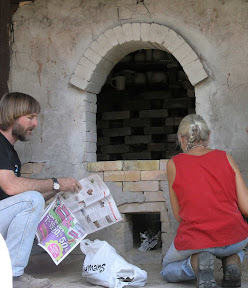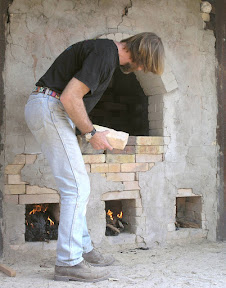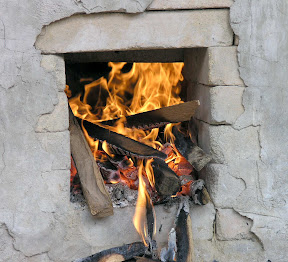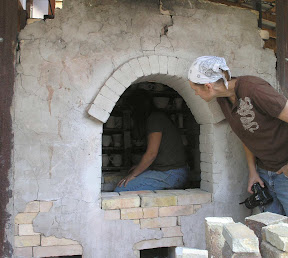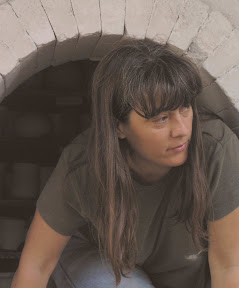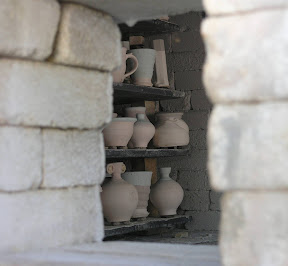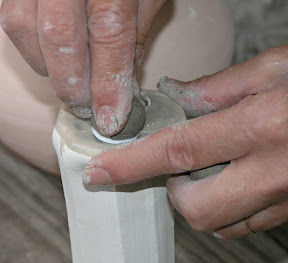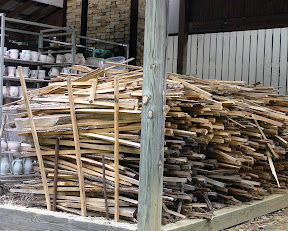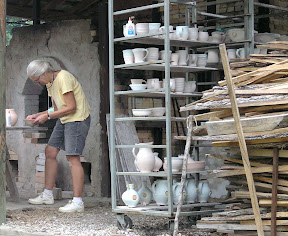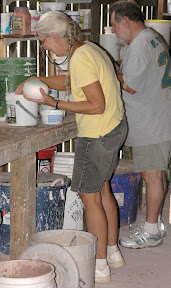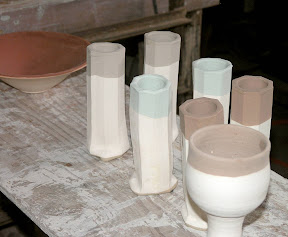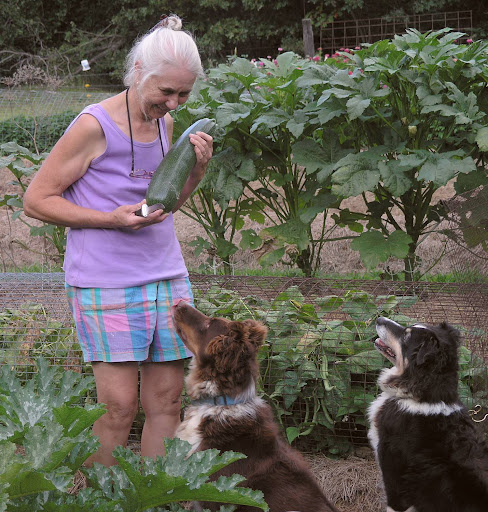The kiln shed at the Ozark Folk Center State Part in Mountain View, Arkansas. I was thankful the kiln is under a shed as numerous thunderstorms passed over Friday evening while the firing was in progress. Off and on drizzle continued Saturday morning. Of course, the shed also protects the kiln from the elements during the rest of the year when it is not in use.
Judi Munn, John Perry and their son, Kai. Judi and John are the potters at the Ozark Folk Center. Judi is putting the waddings on the bottom of a pot.
A kiln load of glazed pots ready for firing. One of the downsides of such a large kiln is test firings are not possible. The potters work for weeks throwing pots, bisque firing and glazing. If something goes wrong with the firing or if there is something wrong with the clay body or glazes, all that work goes down the tubes at one time. Judi and John lost an entire kiln load of pots during an earlier firing. The clay they used was contaminated causing it to bubble and blister during the firing, a heartbreaking discovery to find when opening the kiln up after a firing.
A close up of some of the pots in this kiln load, including three of Jo's funky bud vases. Jo brought several of her bud vases to the firing because she knew they'd be easy to work into place amongst the rest of the pots. John and Judi had the kiln mostly filled with their work before the other potters arrived. This prevented a last-minute rush and chaos while completing the loading.
Note that most of the pots only have glaze applied to their rims and none are glazed all the way down to the base. The front is the hottest part of the kiln. Were a fully glazed pot fired in this area, most of the glaze would melt and drip off onto the kiln shelf. During the firing, these pots will be glazed with molten wood ash.
The front cone pack. Pyrometric cones are pyrometric devices that are used to gauge heatwork during the firing of ceramic materials. The cones are positioned in a kiln with the wares to be fired and provide a visual indication of when the wares have reached a required state of maturity, a combination of time and temperature. Thus, pyrometric cones give a temperature equivalent, they are not simple temperature-measuring devices.
The pyrometric cone is a pyramid with a triangular base and of a defined shape and size; the "cone" is shaped from a carefully proportioned and uniformly mixed batch of ceramic materials so that when it is heated under stated conditions, it will bend due to softening, the tip of the cone becoming level with the base at a definitive temperature. (Wikipedia)
A cone pack for firing a smaller kiln usually contains three cones: The cone you intend to reach and one step below and above. The temperatures within this large kiln varied (hotter in front, cooler in back), hence more cones in the cone pack. As Jo remembers it, the front of the kiln reached Cone 13 while the back only got up to Cone 8 -- more are less. (Cone temperature conversion chart) Because this front cone pack is in the very hottest part of the kiln, it's useless for judging the maturity of the kiln load. It functions more as an early warning system letting you know when to start paying more attention to the cones place in several locations elsewhere in the kiln.
During the firing, the cone packs are viewed through peepholes (removable bricks). After the firing gets going good, you must view the cones through a welder's-type filter lens. For one thing, everything is glowing white hot and the cones are difficult to see without the lens. More importantly, without the lens eye damage is possible.
.

Groundhog Kiln Firing #3








